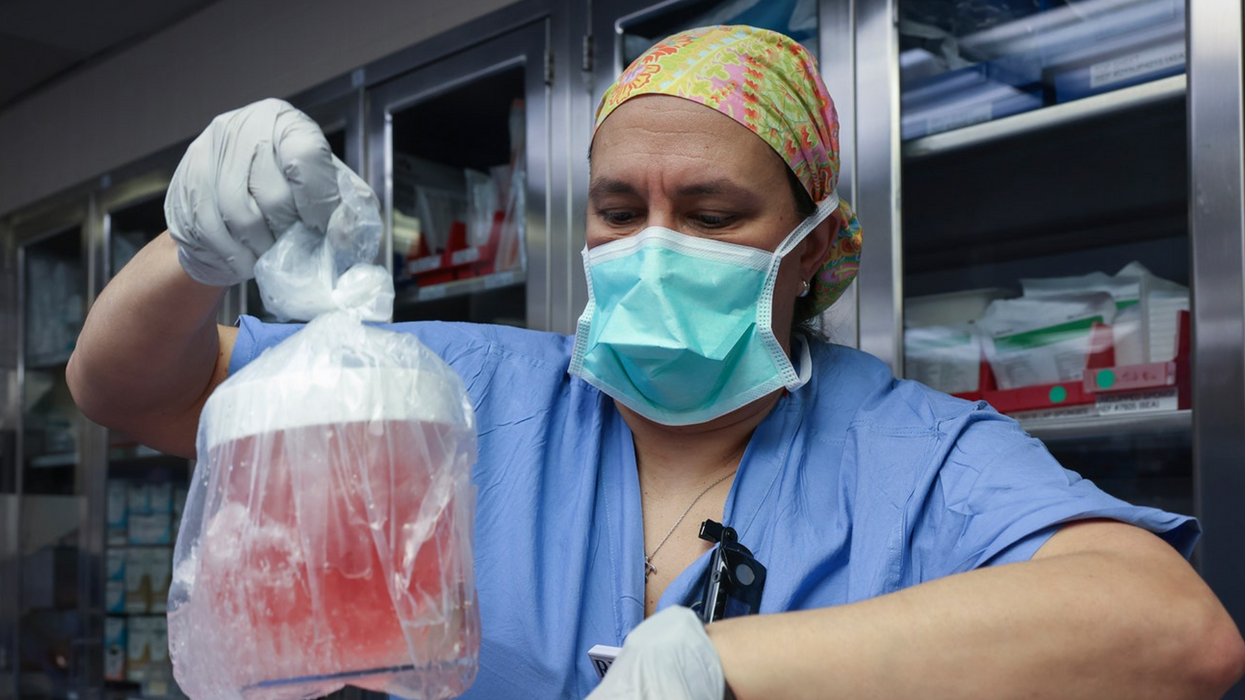Goodnight, Moon. Goodnight, Sky Advertisement.

A rendering of what a sky advertisement would look like.
Imagine enjoying a romantic night stargazing, cozying up for the evening – and you catch a perfectly timed ad for Outback Steakhouse.
Countries have sovereignty over their airspace, but the night sky itself is pretty much an open field.
That's the vision of StartRocket, a Russian startup planning to put well-lit advertisements into outer space. According to a recent interview, StartRocket says its first client is PepsiCo.
The Lowdown
Launching at twilight during the early morning or early evening, the ads will be on cubesats – 10 cm square metallic boxes traditionally used in space. The attached Mylar sails will reflect light from the rising or setting sun, making the ad appear like an "orbital billboard."
The advertisements will need all the solar power they can get: According to a 2016 report, 80 percent of the world and 99 percent of America and Europe experience light pollution at night. Showing advertisements in, say, Wyoming will be much easier than attracting attention in Midtown Manhattan – and risks adding a considerable amount of light pollution to an already overburdened night sky.
Next Up
The StartRocket advertising program is set to begin in 2021. The most recent rate is $20,000 for eight hours of advertising space.
But first, StartRocket has to win over consumers, regulators and space activists.
"I don't see it taking off now," says TED Fellow and University of Texas, Austin Associate Professor Dr. Moriba Jah. Jah is the creator of Astriagraph, an interactive tool to help monitor space junk orbiting Earth. "In general, the space community is anathema to advertisements from orbit to people on the ground… The global astronomy community will be fighting it tooth and nail."
Jah notes SpaceX's launch of 60 satellites last month. "Astronomers were up in arms since they are so bright, you can see them with the naked eye." It got to the point where Elon Musk had to defend himself to the astronomy community on Twitter.
Open Questions
Startups come and go, especially those that are looking for funding. StartRocket is in both categories. Frankly, it's unclear if the ads will actually launch two years from now.
Space advertisements are more likely to be the future for less regulated and financially strapped areas.
The regulatory hurdles are just as unknown. According to Jah, countries have sovereignty over their airspace (think planes, balloons and drones), but the night sky itself is pretty much an open field. This doesn't remove the political ramifications, though, and any American-based launches would have to contend with the FCC, since it regulates advertisements, and the FAA, since it regulates flight.
Carbon credits-style redemptions may help balance out the potential environmental and political damage done by sky ads. It isn't a coincidence that space pioneers Musk, Jeff Bezos, and Richard Branson succeeded at other ventures first, giving them considerably deep pockets to survive red tape – something StartRocket's team doesn't have at the moment.
Space advertisements are more likely to be the future for less regulated, financially strapped areas. Depending on how ad companies negotiate with the local governments, it's easy to picture Kolkata with an "Enjoy Coke" advertisement blaring during a Ganges sunset.
"In rural places, it would be like having another moon," Jah says. "People would say the rich are now taking the sky away from us."
Urinary tract infections account for more than 8 million trips to the doctor each year.
Few things are more painful than a urinary tract infection (UTI). Common in men and women, these infections account for more than 8 million trips to the doctor each year and can cause an array of uncomfortable symptoms, from a burning feeling during urination to fever, vomiting, and chills. For an unlucky few, UTIs can be chronic—meaning that, despite treatment, they just keep coming back.
But new research, presented at the European Association of Urology (EAU) Congress in Paris this week, brings some hope to people who suffer from UTIs.
Clinicians from the Royal Berkshire Hospital presented the results of a long-term, nine-year clinical trial where 89 men and women who suffered from recurrent UTIs were given an oral vaccine called MV140, designed to prevent the infections. Every day for three months, the participants were given two sprays of the vaccine (flavored to taste like pineapple) and then followed over the course of nine years. Clinicians analyzed medical records and asked the study participants about symptoms to check whether any experienced UTIs or had any adverse reactions from taking the vaccine.
The results showed that across nine years, 48 of the participants (about 54%) remained completely infection-free. On average, the study participants remained infection free for 54.7 months—four and a half years.
“While we need to be pragmatic, this vaccine is a potential breakthrough in preventing UTIs and could offer a safe and effective alternative to conventional treatments,” said Gernot Bonita, Professor of Urology at the Alta Bro Medical Centre for Urology in Switzerland, who is also the EAU Chairman of Guidelines on Urological Infections.
The news comes as a relief not only for people who suffer chronic UTIs, but also to doctors who have seen an uptick in antibiotic-resistant UTIs in the past several years. Because UTIs usually require antibiotics, patients run the risk of developing a resistance to the antibiotics, making infections more difficult to treat. A preventative vaccine could mean less infections, less antibiotics, and less drug resistance overall.
“Many of our participants told us that having the vaccine restored their quality of life,” said Dr. Bob Yang, Consultant Urologist at the Royal Berkshire NHS Foundation Trust, who helped lead the research. “While we’re yet to look at the effect of this vaccine in different patient groups, this follow-up data suggests it could be a game-changer for UTI prevention if it’s offered widely, reducing the need for antibiotic treatments.”
MILESTONE: Doctors have transplanted a pig organ into a human for the first time in history
A surgeon at Massachusetts General Hospital prepares a pig organ for transplant.
Surgeons at Massachusetts General Hospital made history last week when they successfully transplanted a pig kidney into a human patient for the first time ever.
The recipient was a 62-year-old man named Richard Slayman who had been living with end-stage kidney disease caused by diabetes. While Slayman had received a kidney transplant in 2018 from a human donor, his diabetes ultimately caused the kidney to fail less than five years after the transplant. Slayman had undergone dialysis ever since—a procedure that uses an artificial kidney to remove waste products from a person’s blood when the kidneys are unable to—but the dialysis frequently caused blood clots and other complications that landed him in the hospital multiple times.
As a last resort, Slayman’s kidney specialist suggested a transplant using a pig kidney provided by eGenesis, a pharmaceutical company based in Cambridge, Mass. The highly experimental surgery was made possible with the Food and Drug Administration’s “compassionate use” initiative, which allows patients with life-threatening medical conditions access to experimental treatments.
The new frontier of organ donation
Like Slayman, more than 100,000 people are currently on the national organ transplant waiting list, and roughly 17 people die every day waiting for an available organ. To make up for the shortage of human organs, scientists have been experimenting for the past several decades with using organs from animals such as pigs—a new field of medicine known as xenotransplantation. But putting an animal organ into a human body is much more complicated than it might appear, experts say.
“The human immune system reacts incredibly violently to a pig organ, much more so than a human organ,” said Dr. Joren Madsen, director of the Mass General Transplant Center. Even with immunosuppressant drugs that suppress the body’s ability to reject the transplant organ, Madsen said, a human body would reject an animal organ “within minutes.”
So scientists have had to use gene-editing technology to change the animal organs so that they would work inside a human body. The pig kidney in Slayman’s surgery, for instance, had been genetically altered using CRISPR-Cas9 technology to remove harmful pig genes and add human ones. The kidney was also edited to remove pig viruses that could potentially infect a human after transplant.
With CRISPR technology, scientists have been able to prove that interspecies organ transplants are not only possible, but may be able to successfully work long term, too. In the past several years, scientists were able to transplant a pig kidney into a monkey and have the monkey survive for more than two years. More recently, doctors have transplanted pig hearts into human beings—though each recipient of a pig heart only managed to live a couple of months after the transplant. In one of the patients, researchers noted evidence of a pig virus in the man’s heart that had not been identified before the surgery and could be a possible explanation for his heart failure.
So far, so good
Slayman and his medical team ultimately decided to pursue the surgery—and the risk paid off. When the pig organ started producing urine at the end of the four-hour surgery, the entire operating room erupted in applause.
Slayman is currently receiving an infusion of immunosuppressant drugs to prevent the kidney from being rejected, while his doctors monitor the kidney’s function with frequent ultrasounds. Slayman is reported to be “recovering well” at Massachusetts General Hospital and is expected to be discharged within the next several days.
